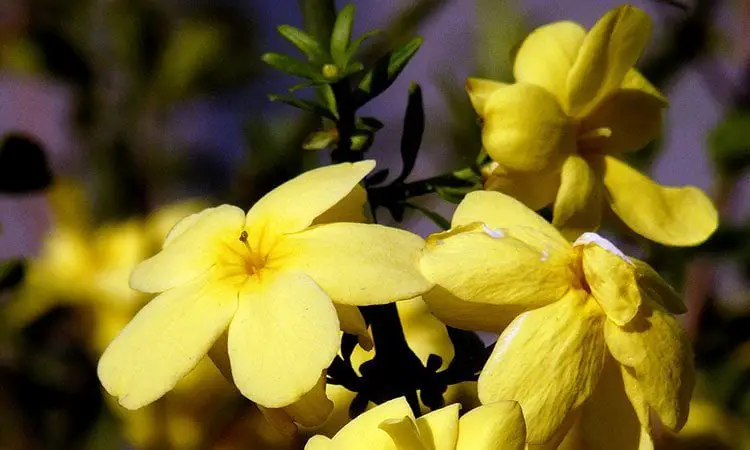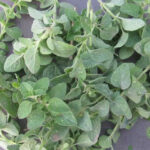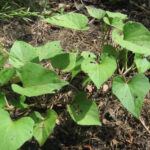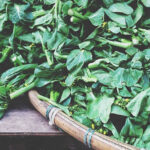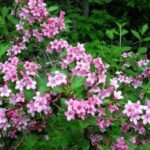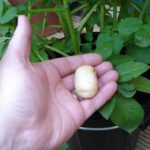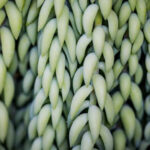Blooming in the summertime, the jamsine plant is known for its exotic fragrance on warm evenings. This scent is used in perfumes, and the fragrant flowers are widely popular, too — varieties are the national flowers of the Philippines, Indonesia, and Pakistan.
Not all jasmines are aromatic, though many popular varieties are. Some prefer warmer climates and bloom in the heat, and others are everblooming and make great houseplants. While many are cared for like a sprawling shrub, there are vining varieties and ground covers. There’s even some which aren’t true jasmines.
Are you considering trying to grow jasmine shrubs? Confused about what’s actually jasmine and what isn’t? Then read on, and we’ll explore the species in detail!
Listen to this post on the Epic Gardening Podcast
Subscribe to the Epic Gardening Podcast on iTunes
Quick Care Guide
| Common Name(s) | Jasmine |
| Scientific Name | Jasminum |
| Family | Oleaceae |
| Height | Variable by cultivar, from 1’-6’ if vining, 1’-4’ if shrub |
| Light | Full sun to partial shade |
| Water | Moderate |
| Soil | Well-drained, moderately fertile |
| Fertilizer | Regular applications |
| Pests and Diseases | Root knot nematodes, whiteflies, mealybugs, blight, rust, fusarium wilt |
All About the Jasmine Plant
Jasmine plants are members of the Jasminum genus, which is classed in the olive family, Oleaceae. Within this genus are over 200 plants native to tropical regions of Africa, Eurasia, and Oceania. Most jasmine plants are cultivated for their fragrant flowers.
Some species are evergreen, and others are deciduous. Among jasmine species, there are varying growth habits of vines and shrubs. Their leaves are opposite or alternating on their stems, and jasmine flowers bloom in clusters of three or singly. The 1-inch jasmine flower colors range from white to yellow, and sometimes red.
Botanists credit the original cultivation of jasmine plants to the people of Persia, in the area of the world contemporarily known as Iran. It was brought to Egypt around 1000 BC and shortly thereafter introduced in other areas of the Mediterranean, where it’s now naturalized.
Jasmine oils and teas are prized the world over, and the floral scent is common in personal care products. Its flavors are used in tons of culinary confections, and the plant is used in medicine as well.
Types of Jasmine Plants
There’s around 200 varieties of jasmine, and here we’ll look at a few of the popular ones.
Jasminum officinale ‘Common jasmine’, ‘Summer jasmine’, ‘Poet’s jasmine’
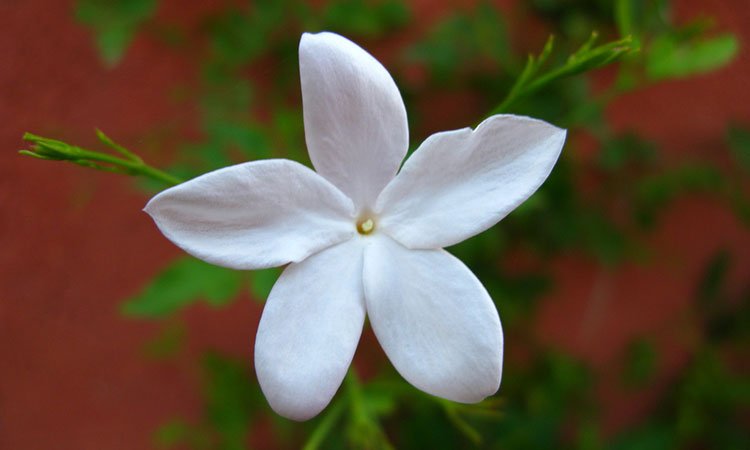
This semi-evergreen white-flowered deciduous climber is the state flower of Pakistan. The five-petaled flowers of common jasmine are star-shaped, and its slightly-fuzzy leaves are sharply pointed. It blooms in summer, although common jasmine can be encouraged to flower at other times in climate-controlled greenhouses. White jasmine flowers are harvested for essential oils, as they are aromatic.
Jasminum grandiflorum ‘Spanish jasmine’, ‘Royal jasmine’

Jasminum officinale forma grandiflorum, or Jasminum grandiflorum, is a subset of the officinale variety. It is raised for aromatics, and for the perfuming and food industries. It is a bush or shrub, that can also be trained to climb.
Jasminum nudiflorum ‘Winter jasmine’
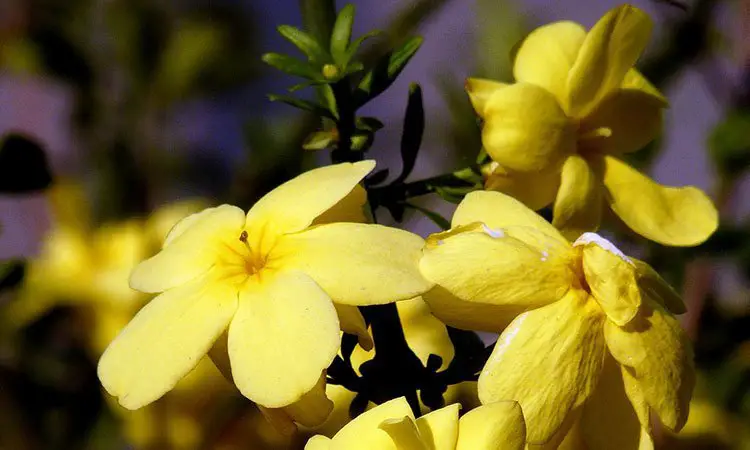
Winter jasmine flowers earlier in the year than other varieties, in late winter or early spring. It produces brilliant yellow flowers on vines, and winter jasmine is best trained to a trellis or used as a mounding ground cover.
Jasminum sambac ‘Arabian jasmine’
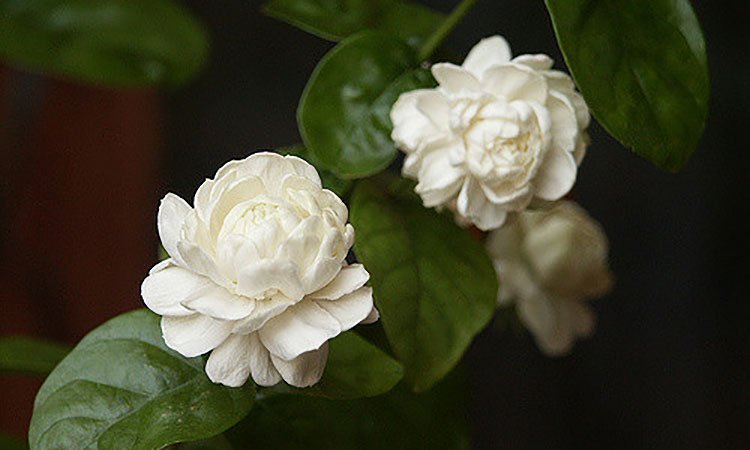
An Arabian jasmine shrub flourishes in warm environments, and is classified as an exotic invasive in Florida. It sprawls, and while it typically grows 4-6 feet tall and wide, it can reach 10 feet. As a shrub Arabian jasmine bushes out, but it can be trained as an evergreen vine. It has glossy leaves, and attractive, multilayered white flowers. It’s used to make leis in Hawaii, and is the national flower of the Philippines and Indonesia. It’s also used in jasmine teas.
Jasminum parkeri ‘Dwarf jasmine’

Dwarf jasmines are popular as potted plants or in topiaries. It’s an evergreen shrub, about a foot tall and with small stems, and it sprawls a few feet across. It is an evergreen, and produces clumps of five-petaled yellow flowers. It does not produce as strong of an aroma as Jasminum officinale or sambac.
Jasminum fruticans ‘Wild jasmine’
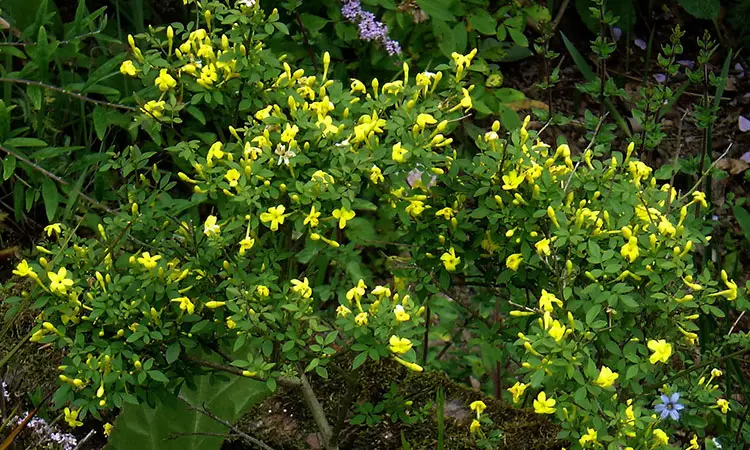
This jasmine loves a Mediterranean climate, and produces prolific yellow flowers on vibrant green foliage from spring through the fall. It grows about 4 feet tall and wide, but when trained as a vine requires support. Wild jasmine is odorless. It was first documented by the Padova Botanic Garden in Venice, Italy in 1545!
For a similar look with more of a scent, try the east Asian and southern US adapted Jasminum mesnyi, also known as primrose jasmine.
Jasminum dichotomum ‘Gold Coast jasmine’
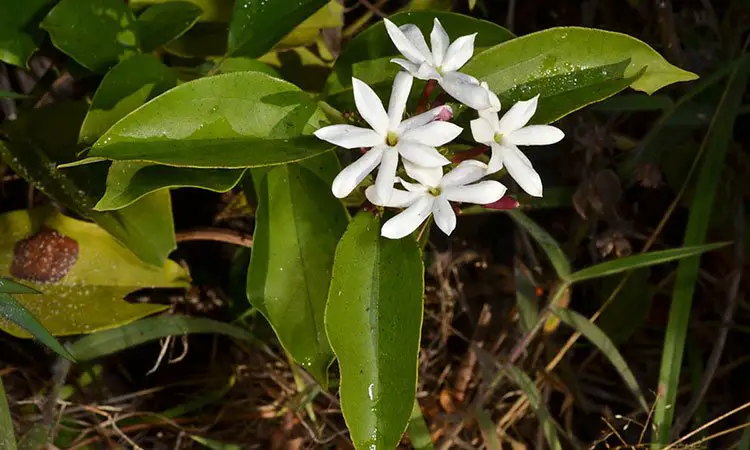
This woody jasmine vine originated in Africa. It produces pink buds that bloom into six-petaled white flowers year-round in warm climates, and has shiny dark green leaves. However, it’s an invasive plant in many regions.
Jasminum polyanthum ‘Pink jasmine’
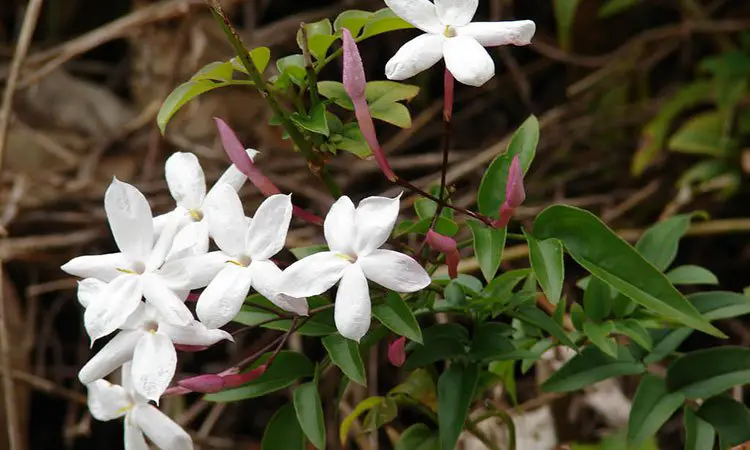
This varietal is popular as a house plant, as it grows long, trailing vines. It reaches heights of six feet if supported by a trellis. Its copious pink buds appear in spring, and bloom into five-petaled star-like white flowers. It blooms year-round in warmer climates or indoors.
False Jasmines
There are multiple other plants that are commonly called jasmine, but aren’t related. Here are some of those!
Cestrum nocturnum ‘Night-blooming jasmine’, ‘Lady of the night’
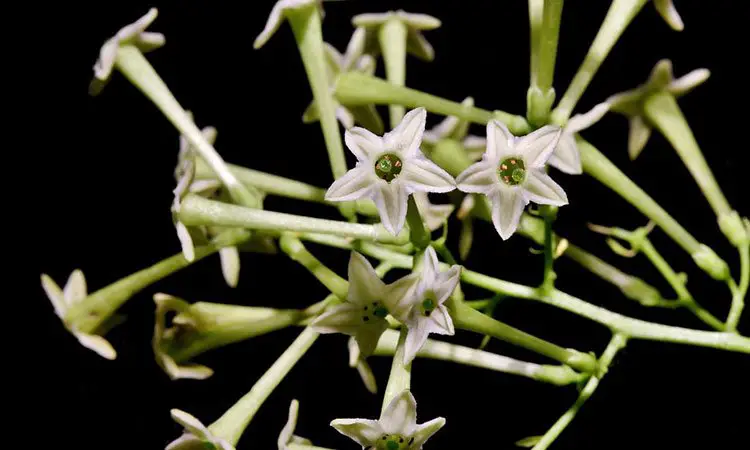
Also called night-blooming jessamine, it’s actually a member of the potato family. These jasmine flowers produce a sweet aroma, but people with respiratory issues or asthma often have problems around this plant. It’s often considered to be a poisonous and invasive plant as well. But its tubular white flowers with have a star-shaped blossom at the end can be mistaken for vining jasmine. Still, for all of its dangers, it is beautiful!
Trachelospermum jasminoides ‘Star jasmine’
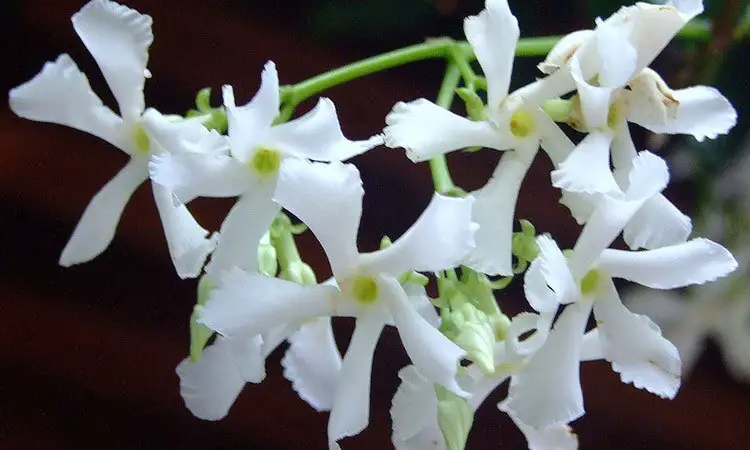
Found in southern California or other warm areas of the United States, this namesake of a true jasmine is actually a different shrubby vine. Its growth, creamy-white flowers, and sweet fragrance all seem to emulate true jasmine. While it survives in the southern US, it is an annual in most regions. Bring the plant indoors in cold. Check the botanical name to make sure that you’re getting the right plant.
Gardenia jasminoides ‘Cape jasmine’

While this gardenia has white flowers and shiny dark green foliage, that’s where its similarity to jasmine ends. It also has a scent, but it’s more similar to gardenia than to jasmine. It also has different growth patterns and care needs.
Planting Jasmine
Most jasmine species like warmer climates. You can grow jasmine year-round in zones 9-11. Some species, like Jasminum officinale, are winter-hardy to zone 7 with protection. This one your can plant indoors as a houseplant. Plant jasmine after the last frost passes, or start growing jasmine indoors a few weeks before.
Jasmine prefers a warm, sheltered place, but vining varieties grow tall.These make beautiful arbor or trellis plants and must be trained early. If you’re growing jasmine indoors, select a warmer portion of your home with regular sunlight. They also prefer humid environments. In the planting process, plant it at the same level it was in the nursery pot.
Jasmine Plant Care
Overall, growing jasmine can be relatively simple, but there are some things to be mindful of in the course of your jasmine plant care process.
Light and Temperature
Most jasmine varieties prefer full sun to light shade. They do not like full shade locations as those are too cool for adequate growth. In temperatures below 60°F, bring your jasmine in or shelter it with a frost cloth. Outdoors, growing jasmine in zones 7 through 10 will involve die back in winter. Due to their perennial nature, they should return in early spring.
Water and Humidity
Jasmine prefers regular watering, and most cultivars require humidity to properly bloom. Indoors, ensure your soil is slightly more moist than if it were outdoors, as the evaporation of the water aids blooming – but make sure you’re not growing jasmine in soggy soil! Overwatering can create conditions where diseases thrive. 50% humidity is ideal.
Soil
Jasmine prefers well-drained soil. Different cultivars like it a bit sandier than others. Clay soils are not recommended for growing jasmine without serious amendment to lighten the soil content. In winter for zones 9-11, mulch to help keep the roots and base of the plant warm. If it’s grafted, mulch for root warmth, but leave an indentation in the mulch right around the graft joint so that it is not covered.
Fertilizer
Jasmine is a heavy feeder, so be prepared to fertilize regularly. If you want to grow jasmine rapidly, offer a higher nitrogen fertilizer, which helps when trying to establish a vine-covered arbor or a larger shrub. Jasmine likes lots of phosphorous to encourage blossom development. Use a standard balanced fertilizer if you don’t have one ideally suited to Jasminum species.
Pruning
You may need to prune aggressively during warm weather when the plants have an explosion of growth. Regularly train vining varieties on their supports and secure the weaker vines. Pinch off excess vines, and trim vines to promote forking. With a shrub, prune to maintain the size/shape of shrub. Don’t prune too much that the plant doesn’t have enough surface area for photosynthesis.
If you are growing jasmine as a hedge plant, focus initially on trying to promote bushy growth. When it has reached the size you want, regularly pinch or trim excess growth to maintain it.
Jasmine Plant Propagation
While some varieties of jasmine do set seed, most seed is unreliable and is not guaranteed to germinate. It is easiest to propagate jasmine by taking stem cuttings about 4-6” in length, applying a coating of root hormone to the cut end, and then placing into a container of potting soil. Some nurseries also offer grafted plants where another Jasminum subspecies is grafted onto an officinale root base.
Mound layering is another viable way to propagate jasmine. Find a node on your vine or bush close to the ground. Use a pruning knife to cut into the node slightly, and pin the marred branch to the earth with some soil and a rock. When new growth appears on the pinned section, cut it off the parent plant, and pot it up, or leave it to spread.
Troubleshooting Your Jasmine Plant
When you’re growing jasmine, you’ll encounter few pests or diseases. Here are the most common and how to handle them.
Growing Problems
If you planted an invasive jasmine, you may find it sprawling all over your garden, choking out other plants. To prevent this, deadhead jasmine flowers just after they fade, and prune aggressively. Remove any suckers from the base of the plant.
If you planted your jasmine in a dry environment, it will not bloom. You can ensure lovely fragrant blooms by planting in moisture retentive soil, or by providing a pebble tray with water. A plant humidifier placed next to indoor jasmines also works.
Pests
The most common pests for jasmine species are root knot nematodes, mealybugs, and whiteflies. Of these, the nematodes are the most problematic as they’re the hardest to eradicate, but application of beneficial nematodes to your plant’s soil should aid in this process. An application of neem oil will handle most other insect issues.
However, if pollinators are plentiful in your garden, avoid spraying neem outside dawn and dusk, when pollinators are most active. Apply a light mist over your plants. Even then, you could still damage pollinators. A more clandestine stream of water treatment, or more targeted spot removal may be better if you host pollen-lovers.
Diseases
The most common diseases for jasmine are blight, rust, and Fusarium wilt. Preventing these is far easier than treatment, as the soil may be infected. Avoid watering from the top of the plant, and prune for circulation so the plant’s leaves and stems remain dry. If your plant is affected by any of these, treat with a copper fungicide. You can also try to replant it in fresh soil after trimming away diseased parts.
Like even organic pesticides, fungicides can negatively affect pollinators. Use these with caution.
Frequently Asked Questions
Q: Why isn’t my jasmine blooming?
A: Overfertilization with too much nitrogen in your soil promotes more foliage but less flowering. Extra phosphorous can remedy the issue. High temps in the upper 90’s and above can cause heat stress and slow flowering. Some varieties like winter jasmine require a fall “rest period” when it doesn’t produce a jasmine flower and needs cooler temperatures.
Q: Is there a best fertilizer type for jasmine?
A: A balanced to slightly-higher nitrogen fertilizer will give the plant everything it needs to promote lush green growth. For jasmine flowers, opt for a higher phosphorous fert. Potassium spurs root growth.
Q: Is jasmine rice related to or scented with jasmine?
A: Jasmine rice is completely unrelated. It’s a long-grain white rice that naturally has a jasmine-like subtle fragrance, but this doesn’t come from jasmine’s white flowers.
Q: Where is the best place to put a jasmine plant?
A: Plant your jasmine in full sun with some partial shade, in well-draining soil.
Q: Is jasmine indoor or outdoor plant?
A: Depending on the cultivar and your climate, you can grow jasmine flower indoors or outdoors. Flowering shrubs are typically easier to keep indoors.
Q: Is jasmine toxic to dogs?
A: The ASPCA says it is non-toxic to dogs.
Q: What month does jasmine bloom?
A: Most cultivars bloom from spring to fall, but there are some winter-blooming varieties, like winter jasmine, for instance. The months these seasons occur in your region are those in which jasmine blooms.
Q: Does jasmine plant attract snakes?
A: Dense plants can provide habitat for snakes.

